1. Introduction
The impact of the environmental accumulation and contamination of hydrazine (N2H4) and sulfite (SO32ŌłÆ) and nitrite (NO2ŌłÆ) ions on the human health and ecosystem is a major concern [1-4]. Concurrent monitoring of the variations in the concentrations of N2H4, SO32ŌłÆ, and NO2ŌłÆ is essential for understanding their biogeochemical processes in aquatic environments and to develop better strategies for managing the water quality, wastewater treatment, and food industry. Hydrazine is widely used as a starting material in the production of some insecticides, herbicides, pesticides, dyestuffs, and explosives, as well as in the preparation of several pharmaceutical derivatives [5]. The N2H4 is also an ideal fuel for the direct fuel cell system because its fuel electrooxidation process does not suffer from any poisoning effects [6-9]. Compounds containing SO32ŌłÆ ions are used as preservatives in view of their antioxidant properties and as inhibitors of enzymatic and microbial activities in beverages, food, and pharmaceutical products [10]. The NO2ŌłÆ ion is a typical inorganic pollutant and its sources include wastes from fertilizer and preservative industries and adulterants in food [11-14]. Therefore, it is important and desirable to design and develop a catalyst for the concurrent detection and determination of N2H4, SO32ŌłÆ, and NO2ŌłÆ present in food, water, biological fluids, etc. Electrochemical techniques have been found to be the most promising methods for the determination of N2H4, SO32ŌłÆ, and NO2ŌłÆ [12]. Electrochemical oxidation of these analytes at a bare electrode is normally accompanied with a high overpotential, which represents a slugish electron transfer process. Hence, distinguishing each analyteŌĆÖs redox behavior is not possible at the bare electrode. The facile modification of the electrode surface would reduce the overpotential and increase the catalytic current for such analytes [15-17]. Such surface-modified electrodes enhance the rate of electron transfer by reducing the overpotential associated with the reaction and could distinguish the redox behavior of each of the analyte.
Au nanostructures (NSs) have attracted much attention as an electrocatalyst that exhibits higher catalytic activity toward various analytes [14,18,19]. The electrocatalytic property of Au nanoparticles (NPs) mainly depends on their preparation methods [19,20]. Previously, Maduraiveeran et al. [15] reported the concurrent sensing of N2H4, SO32ŌłÆ, and NO2ŌłÆ with a large decrease in the overpotentials using a colloidal Au NPs-modified electrode. In the present work, the concurrent electrocatalytic oxidation and sensing were studied using a mixture of N2H4, SO32ŌłÆ, and NO2ŌłÆ electrodeposited at the Au NS-modified electrode. ╬▓-Cyclodextrin (CD) mixed with amine-functionalized silicate solŌĆōgel matrix (SSG) composite was used to modify the glassy carbon (GC) electrode surface prior to electrodeposition. For Au deposition, CD was used as an additive, and it acted as a structure-directing agent. The results were compared with those of the Au NSs fabricated in the absence of CD.
2. Experimental Section
2. 1 Materials and methods
Gold(III) chloride (HAuCl4), ╬▓-cyclodextrin, NŌĆÖ- [3-(trimethoxysilyl) propyl] diethylenetriamine (silane monomer used to prepare SSG), and hexaammineruthenium(III) chloride (Ru(NH3)6Cl3) were obtained from Sigma-Aldrich. Hydrazine hydrate, sodium sulfite, and sodium nitrite were purchased from Merck. All the glassware was thoroughly cleaned with aqua regia (HNO3/HCl (1:3) v/v) (caution: aqua regia is a powerful oxidizing agent and it should be handled with extreme care) and rinsed extensively with distilled water before use. The scanning electron microscopy (SEM) images were obtained for the electrodeposited films on an indium tin oxide (ITO) substrate using a JEOL JSM-7800F. We have used the ITO electrodes only for SEM measurements and the GC electrode for electrochemical studies. The cyclic voltammograms (CVs) and square wave voltammograms (SWVs) of the modified electrodes were recorded using Ivium TechnologiesŌĆÖ electrochemical workstation. The electrochemical experiments were performed using a single-compartment three-electrode cell. The GC electrode (with a geometric area of 0.07 cm2) was used as the working electrode and a platinum wire as the counter electrode. The reference electrode was Ag/AgCl (in 3M NaCl). The electrolyte solution was deaerated by purging nitrogen gas for 30 min prior to each experiment.
2.2 Preparation of SSG-CD composite
A homogeneous SSG-CD composite was prepared [19] by the addition of 10 ╬╝L of 1 M silane monomer to 10 mL of 7 mM aqueous CD solution under vigorous stirring and the stirring was continued for another 60 min.
2.3 Electrode fabrication
The Au NSs-modified electrodes were prepared using a previously reported procedure [21]. Briefly, a known amount (5 ╬╝L) of SSG or SSG-CD composite was drop-casted on the GC electrode and allowed to dry at 37Ōäā for 1 h. The Au NSs were electrodeposited at the modified electrode by applying a potential of ŌłÆ0.2 V (Ag/AgCl) for 300 s using an electrolyte solution containing 3 mM HAuCl4 and 0.5 M H2SO4. The prepared modified electrodes are represented as GC/Au, GC/SSG-Au, and GC/SSG-CD-Au. For the SEM measurements, ITO electrodes (1 ├Ś 2 cm) were used instead of the GC electrode. The drop-casted composite volume was 50 ╬╝L. The remaining experimental parameters were the same as in the previously reported procedure.
3. Results and Discussion
3.1 Surface and electrochemical characterization of the modified electrodes
To understand the morphology of the different modified electrodes, the SEM analysis was performed and the images are shown in Fig. 1 and 2. The ITO/SSG-CD electrode without any electrodeposited Au NSs showed a clear image of the SSG film (Fig. 1A). The Au NSs at the ITO/SSG-Au electrode (Fig. 1B) showed randomly inter-connected structures. At the ITO/Au electrode, the Au NSs resembled flowerlike structures (Fig. 1C). However, in the presence of CD in the modified surface of the electrode, the Au NSs were deposited in a different manner at the ITO/SSG-CD electrode (Fig. 1D). The electrodeposited NSs were smaller than those at the other two electrodes and were not inter-connected with each other. The growth of such small Au NSs at the ITO/SSG-CD electrode can be envisaged, as the nucleation of atomic gold in the presence of CD forms Au atomic clusters. The SSG-CD composite at the electrode surface stabilizes the Au atomic clusters, aided by the hydrogen bonding interaction between the secondary ŌłÆOH groups of CD. The Au nucleation centers favor bonding with the other Au nucleation centers, leading to the formation of such small Au NSs [21]. Furthermore, higher magnification images (Fig. 2A-D) revealed the size and shape of the deposited NSs. As Fig. 2C shows, the Au NSs resembled raspberry-like structures, as reported previously [21]. SEM-energy dispersive X-ray (EDX) analysis (Fig. 2E and F) clearly revealed the active presence of CD on the electrode surface and that the NSs were composed of elemental Au.
Fig.┬Ā1.
SEM images of (A) ITO/SSG-CD, (B) ITO/SSG-Au, (C) ITO/Au, and (D) ITO/SSG-CD-Au electrode surfaces.
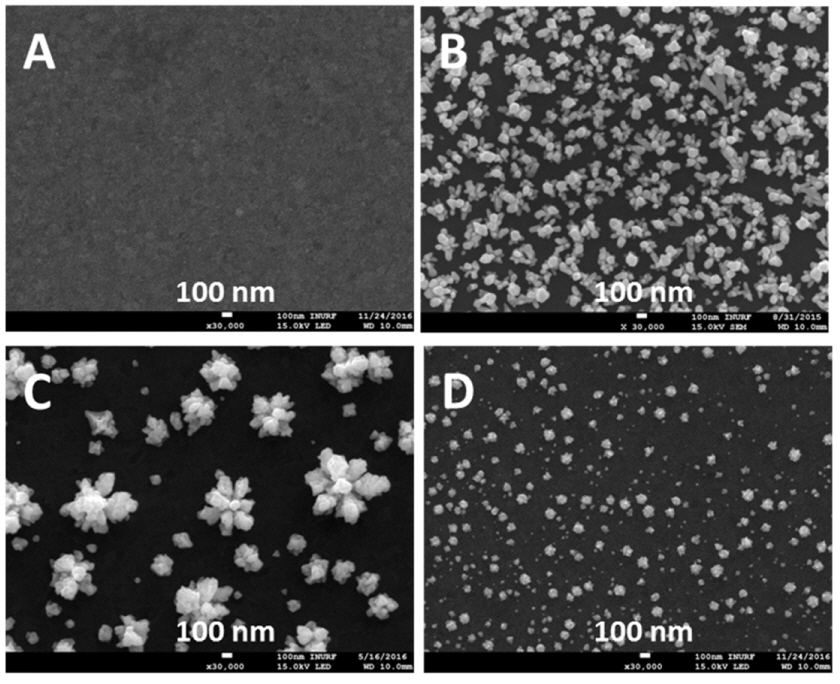
Fig.┬Ā2.
(A-D) SEM images and (E and F) SEM-EDX analysis images of the ITO/SSG-CD-Au electrode surface.
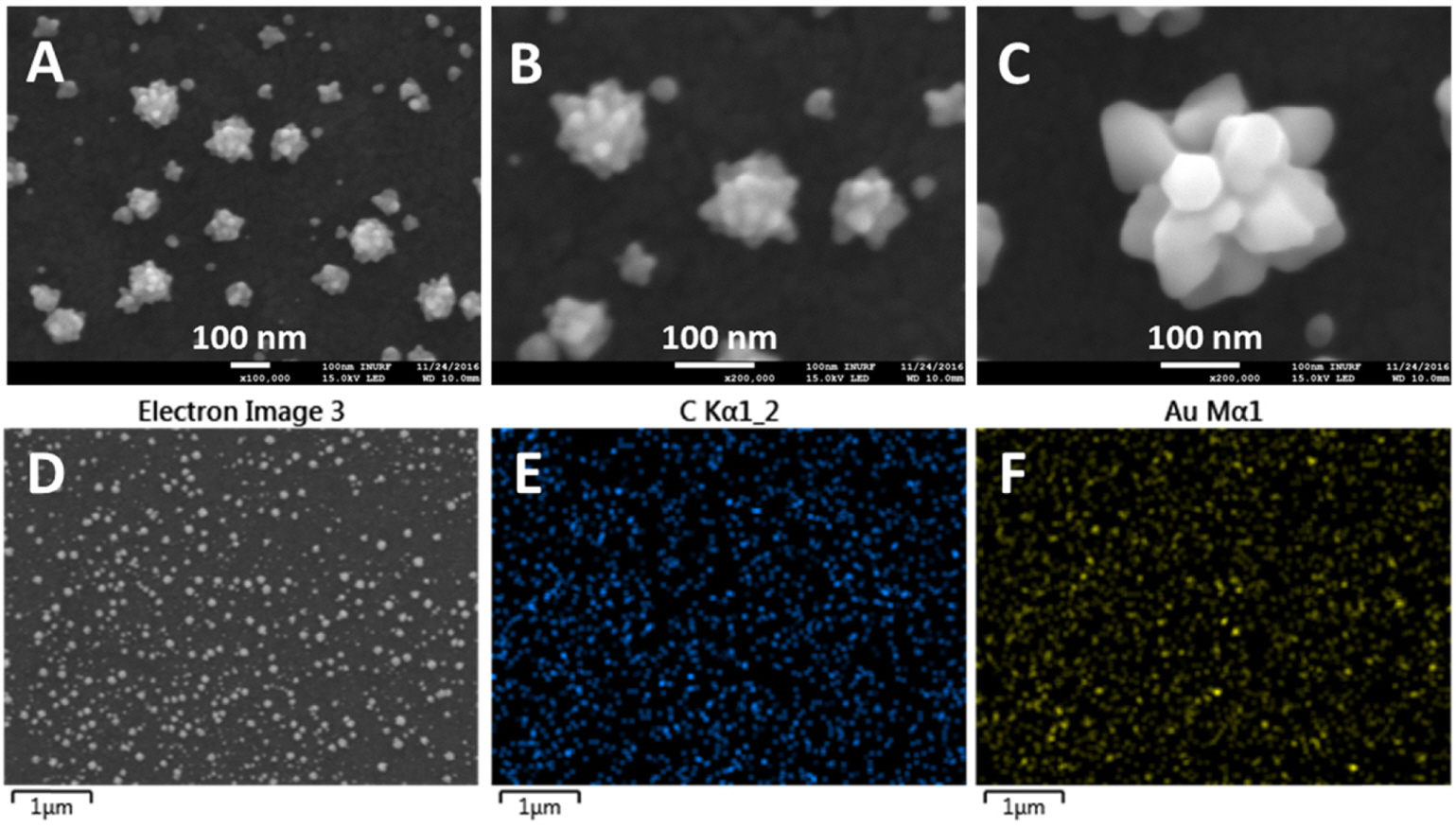
We have used the ITO electrodes only for SEM measurements because the conventional GC electrodes cannot be used for SEM. The electrochemical studies were carried out using the GC electrode. Besides, switching between the ITO and GC substrates would have a negligible impact on the results of this study. Furthermore, the modified surface film (SSG-CD) contributed majorly to the nucleation and growth of the NSs. The Au NSs-deposited electrodes were electrochemically characterized by recording the CVs in the deaerated PBS buffer (pH = 7.2) (Fig. 3A). The oxidation peaks observed around 0.93 V (Fig. 3A(a-c)) were ascribed to the formation of Au oxide and the corresponding reduction peaks were observed around 0.46 V (Fig. 3A(a-c)) because of the reduction of Au oxides [21,22]. Among the different modified electrodes, an increase in the anodic and cathodic peak currents was noticed for the GC/SSG-CD-Au electrode because the highly active Au surface rabidly formed the Au oxide layer at this particular electrode surface. Since the formation of the Au surface oxide and its subsequent reduction are pH dependent [15], a negative shift in the oxidation and reduction peaks (0.927 and 0.455 V, respectively) was observed in the PBS buffer (pH = 7.2), compared to those in an acidic medium (0.5 M H2SO4) for all the Au NSs-modified electrodes [23].
The redox behavior of [Ru(NH3)6]3+ is a valuable tool for testing the kinetic barrier of the interface because the electron transfer between the species in solution and the electrode must occur by electron tunneling through the defects or pinholes in the modified electrode [24]. Fig. 3B(a-d) shows the cyclic voltammetric responses of the bare GC, GC/SSG, GC/SSG-CD, and GC/SSG-CD-Au electrodes, respectively, toward the [Ru(NH3)6]3+ redox marker. As expected, [Ru(NH3)6]3+ exhibited reversible behavior at the bare GC electrode (Fig. 3B(a)) with a peak-to-peak separation (╬öEp) of 83 mV at a scan rate of 50 mV/s in 0.1 M PBS and 0.1 M KCl. The GC/SSG electrode (Fig. 3B(b)) showed a quasi-reversible voltammetric response with a very low peak current and a peak-to-peak separation of 123 mV. The higher peak potential difference (╬öEp) observed at the GC/SSG electrode compared to the bare GC electrode is a measure of the kinetic hindrance/repulsion exerted by SSG toward the electron-transfer process at the electrode surface for the [Ru(NH3)6]3+ ions. This observation (Fig. 3B(b)) revealed that a small amount of the [Ru(NH3)6]3+ ions might diffuse through the pinholes present in SSG. Such pinholes formations are expected during the swelling of SSG. The GC/SSG-CD electrode (Fig. 3B(c)) showed a quasi-reversible voltammetric response with a peak current higher than that of the GC/SSG electrode (Fig. 3B(b)). Furthermore, the response was almost equal to that observed at the bare GC (Fig. 3B(a)) and the peak-topeak separation was 116 mV. Since the CD molecule is electrochemically inert, one cannot expect any electrocatalytic effect of CD on the [Ru(NH3)6]3+ ions. The basic pH (i.e., 9.84) [21] of the SSG-CD composite caused the deprotonation of the ŌłÆOH groups in the CD molecules, thereby making the electrode negatively charged and showing permselective behavior toward the positively charged [Ru(NH3)6]3+ ions. Each peak in the CV corresponds to a particular electroactive species in the test solution, and the height of the peak is proportional to the concentration of the analyte. In this case, the deprotonation of ŌłÆOH groups at the GC/SSG-CD electrode made it negatively charged, and hence, the electrode exhibited permselective behavior toward the positively charged [Ru(NH3)6]3+ ions. Due to this preconcentration effect, the [Ru(NH3)6]3+ ions both from the solution and those adsorbed on the electrode collectively get reduced by Au, leading to an increased reduction current. During the reverse cycle, such preconcentrating effect of the corresponding species was not observed. Hence, there is asymmetry in the behavior of the redox peaks. The GC/SSG-CD-Au electrode (Fig. 3B(d)) also showed a quasi-reversible voltammetric response with a peak current higher than that of the other modified electrodes (Fig. 3B(a-c)), and the peak-to-peak separation was measured to be 133 mV. This observation clearly revealed that the GC/SSG-CD-Au electrode acts as a new electrode with increased electrode area [21,25] and that the Au NSs at the electrode achieve good electrical communication with the underlying electrode surface. It is evident from the higher peak current that the presence of Au NSs at the SSG-CD film shows a marked influence on the barrier property of the GC/SSG-modified electrode.
Fig.┬Ā3.
(A) Cyclic voltammograms recorded at (a) GC/SSG-Au, (b) GC/Au, and (c) GC/SSG-CD-Au electrodes in deaerated 0.1 M PBS buffer (pH = 7.2) at a scan rate of 50 mV/s. (B) Cyclic voltammograms recorded for 3 mM of [Ru(NH3)6]3+ at (a) bare GC, (b) GC/SSG, (c) GC/SSG-CD, and (d) GC/SSG-CD-Au electrodes in deaerated 0.1 M PBS buffer (pH = 7.2) and 0.1 M KCl at a scan rate of 50 mV/s.
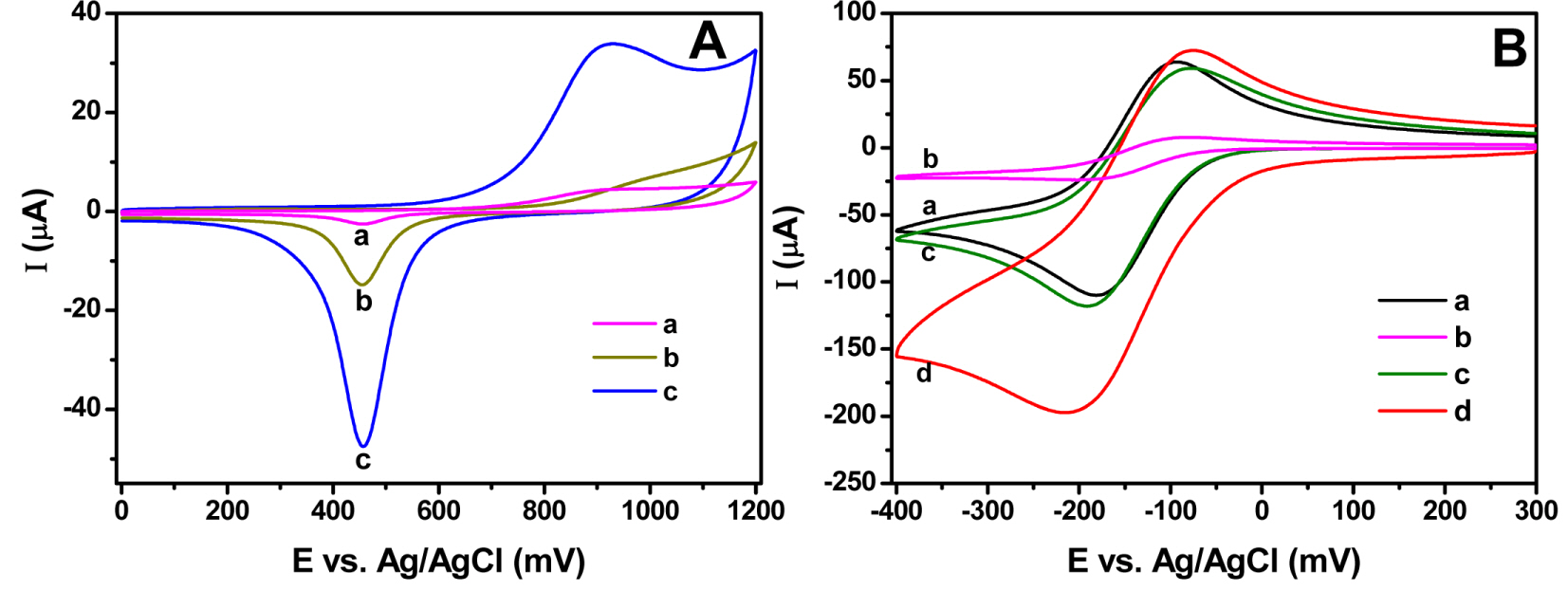
3.2 Concurrent electrooxidation of N2H4, SO32ŌłÆ, and NO2ŌłÆ mixture
In order to evaluate the electrocatalytic ability of the different fabricated Au NSs, the electrooxidation of N2H4, SO32ŌłÆ, and NO2ŌłÆ was studied both individually and concurrently by cyclic voltammetry. The concurrent electrooxidation of the target analytes at the GC/SSG-CD-Au electrode is schematically represented in Fig. 4. Fig. 5(A-C) displays the CVs observed for the electrooxidation of 100 ╬╝M each of N2H4, SO32ŌłÆ, and NO2ŌłÆ, respectively, at the different modified electrodes. Fig. 5D represents the concurrent electrooxidation of a mixture of N2H4, SO32ŌłÆ, and NO2ŌłÆ (100 ╬╝M each) at the different modified electrodes. It was observed that N2H4, SO32ŌłÆ, and NO2ŌłÆ cannot be electrooxidized at the bare GC electrode (Fig. 5(A-D)(a)) within the chosen potential window. The GC/Au electrode exhibited poor electrooxidation behavior for all the three analytes and the mixture (Fig. 5(A-D)(b)). Under the same experimental conditions, the GC/SSG-Au electrode exhibited improved catalytic activity toward all the analytes (Fig. 5(A-D)(c)). However, the GC/SSGCD-Au electrode demonstrated an increase in the anodic peak currents (Fig. 5(A-D)(d)) and also successfully resolved the electrooxidation peaks of all the three analytes (Fig. 5D(d)). In the absence of the analytes, electrochemical responses were not observed at the GC/SSG-CD-Au electrode (Fig. 5(A-D)(e)). The CVs obtained at the GC/SSG-CD-Au electrode demonstrated a decreased overpotential (Epa) and an enhanced peak current (Ipa). Furthermore, the cathodic peak observed around 0.5 V in Fig. 5C could be attributed to the reduction of the Au surface oxides [21].
Fig.┬Ā4.
Schematic representation of simultaneous electrooxidation of N2H4, SO32ŌłÆ, and NO2ŌłÆ at the Au NRBs-modified electrode (GC/SSG-CD-Au).

The experimental results showed well-resolved oxidation peaks for the mixture of 100 ╬╝M each of N2H4, SO32ŌłÆ, and NO2ŌłÆ at the GC/SSG-CD-Au electrode (Fig. 5D(d)) in 0.1 M PBS at 0.100, 0.375, and 0.757 V, respectively, compared to those at the bare GC, GC/Au and GC/SSG-Au electrodes, which were in good agreement with the previous report [15]. The electrochemical responses observed for the mixture were irreversible and no cathodic current was observed during the reverse cycle (Fig. 5D(d)). The faster electron transfer lead to well-resolved peaks and a considerable increase in the peak currents at the GC/SSG-CD-Au electrode. Hence, the N2H4, SO32ŌłÆ, and NO2ŌłÆ species in a mixture can be monitored effectively and simultaneously at the GC/SSG-CD-Au electrode, without any redox mediator or enzyme immobilization.
Fig.┬Ā5.
Cyclic voltammograms obtained for the electrooxidation of 100 ╬╝M each of (A) N2H4, (B) SO32ŌłÆ, and (C) NO2ŌłÆ. (D) Cyclic voltammograms showing concurrent electrooxidation of a mixture of 100 ╬╝M each of N2H4, SO32ŌłÆ and NO2ŌłÆ at the (a) bare GC, (b) GC/Au, (c) GC/SSG-Au, and (d) GC/SSG-CD-Au electrodes and (e) without any analyte in 0.1 M PBS buffer (pH = 7.2) at a scan rate of 50 mV/s.
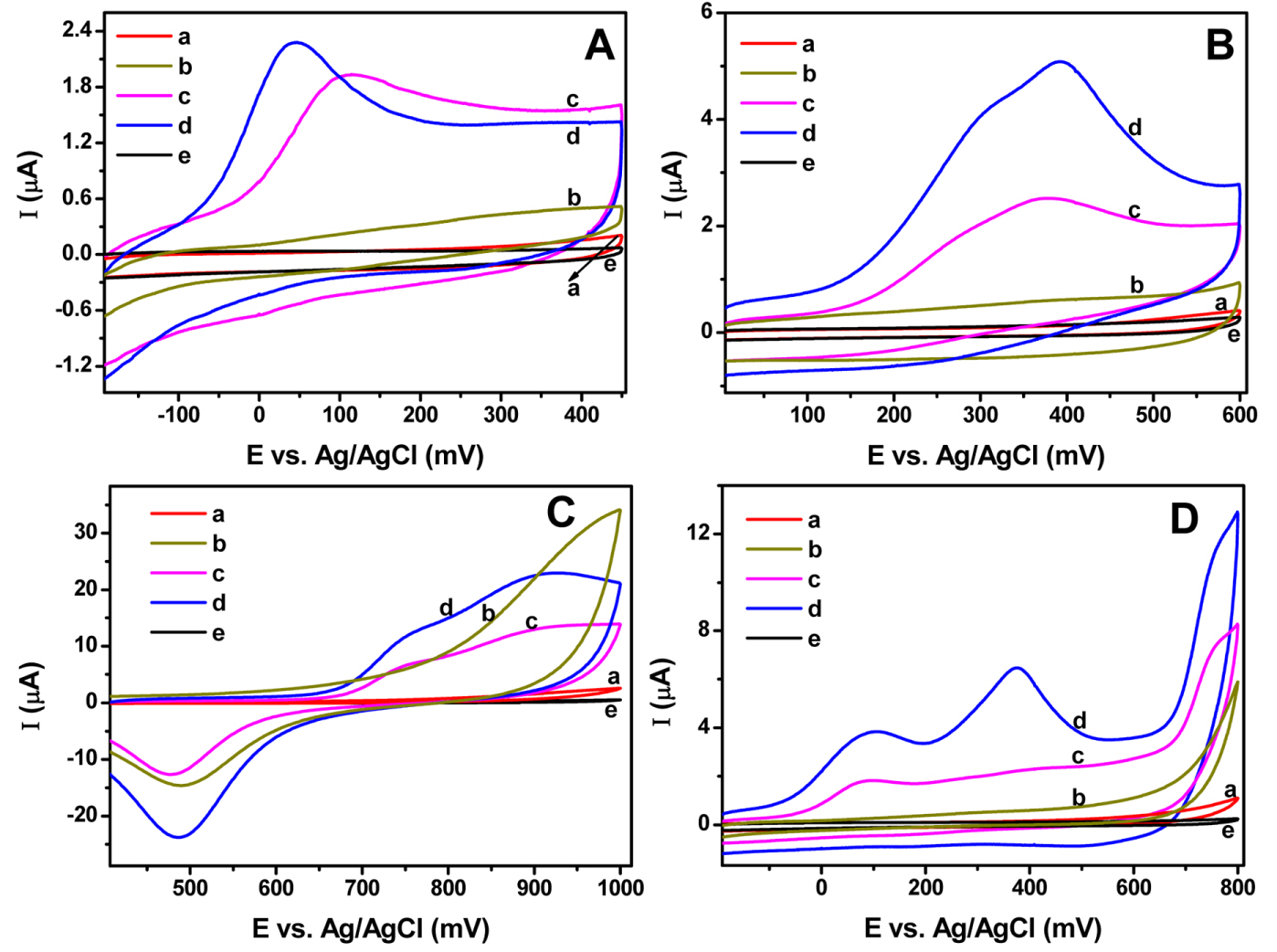
3.3 Concurrent electrochemical sensing of N2H4, SO32ŌłÆ, and NO2ŌłÆ in a mixture
Individual SWVs of N2H4, SO32ŌłÆ, and NO2ŌłÆ were studied (Figs. 6, 7, and 8) at the different modified electrodes. Similar to the electrooxidation behavior, a better electrochemical sensing ability was observed at the GC/SSG-CD-Au electrode for the mixture of analytes with linearly increasing peak currents corresponding to the increasing concentrations of analytes. Furthermore, the sensitivities of the modified electrode for the oxidation of N2H4, SO32ŌłÆ, and NO2ŌłÆ were found to be 0.012, 0.028, and 0.055 ╬╝A/╬╝M, respectively, and the respective correlation coefficients (n = 8) were found to be 0.9970, 0.9890, and 0.9880 (Fig. 10A). The sensitivities of the GC/SSG-CD-Au electrode for NO2ŌłÆ and SO32ŌłÆ were 4.6 and 2.3 times higher than that for N2H4, respectively.
Fig.┬Ā6.
Square wave voltammograms obtained for each addition of 100 ╬╝M N2H4 at the (A) GC/SSG-Au, (B) GC/Au, and (C) GC/SSG-CD-Au electrodes in 0.1 M PBS buffer (pH = 7.2). D: Corresponding calibration plot.

Fig.┬Ā7.
Square wave voltammograms obtained for each addition of 100 ╬╝M SO32ŌłÆ at (A) GC/SSG-Au, (B) GC/Au, and (C) GC/SSG-CD-Au electrodes in 0.1 M PBS buffer (pH = 7.2). D: Corresponding calibration plot.
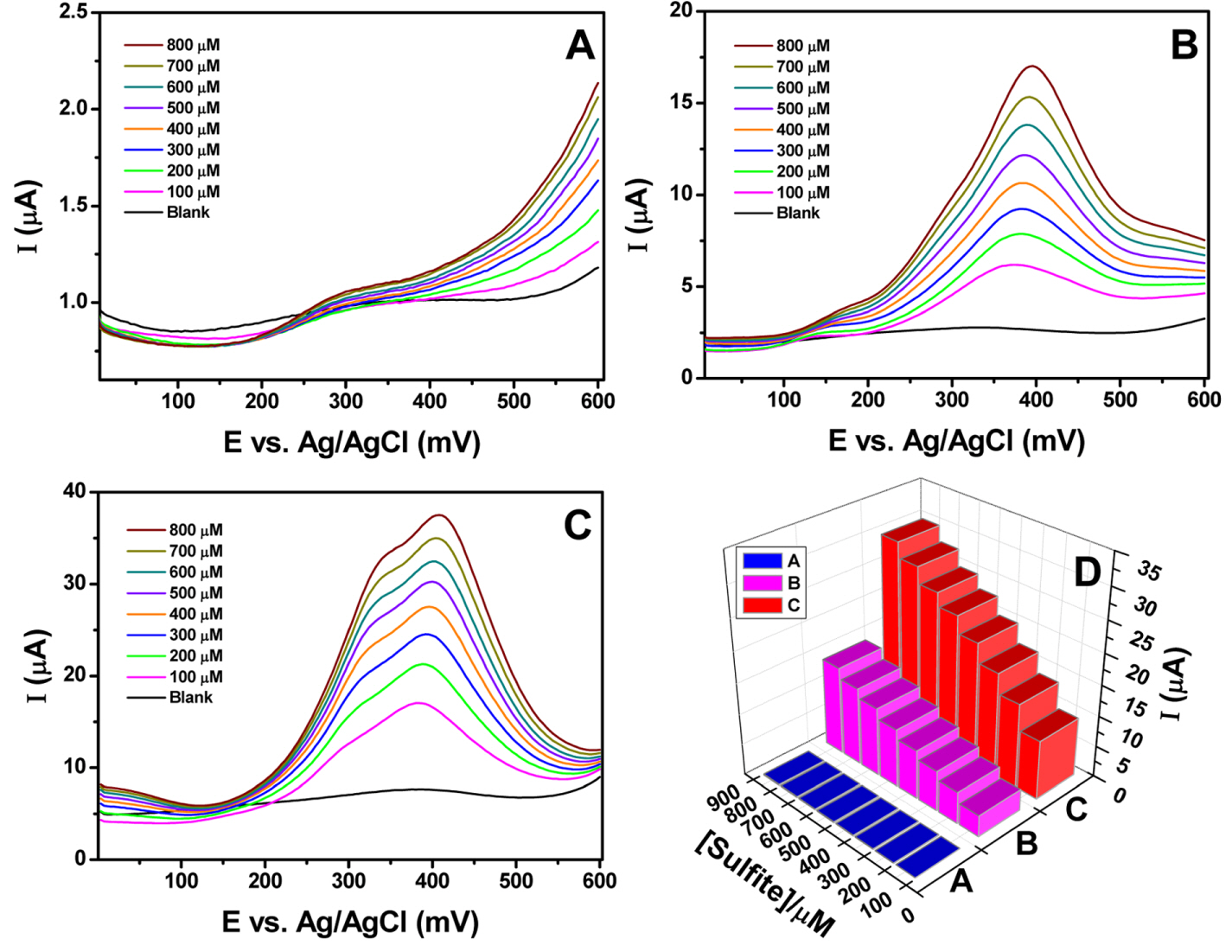
Fig.┬Ā8.
Square wave voltammograms obtained for each addition of 100 ╬╝M NO2ŌłÆ at (A) GC/SSG-Au, (B) GC/Au, and (C) GC/SSG-CD-Au electrodes in 0.1 M PBS buffer (pH = 7.2). D: Corresponding calibration plot.
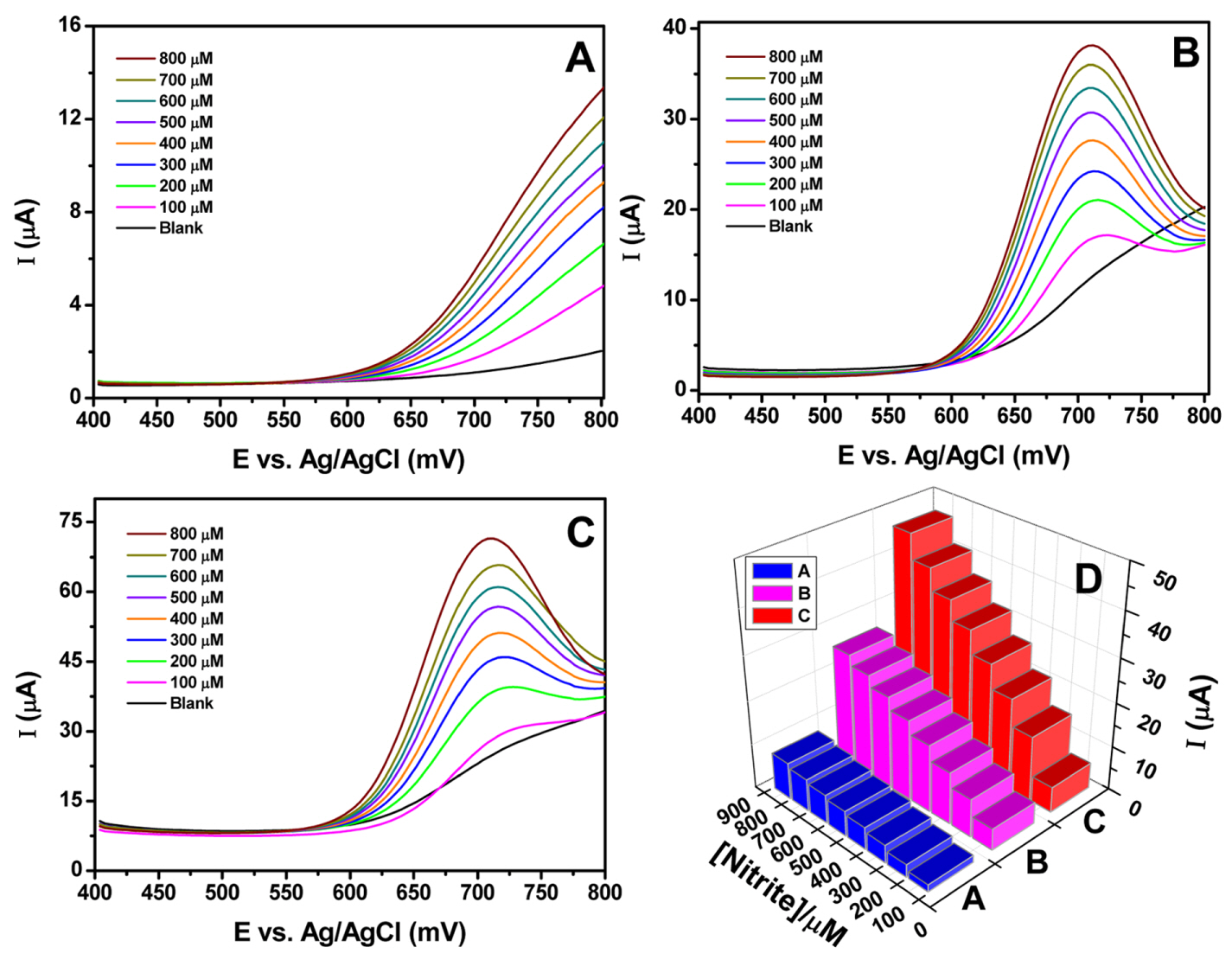
Fig. 9(A-C) illustrates the SWVs observed for the mixture of N2H4, SO32ŌłÆ, and NO2ŌłÆ at the GC/SSG-Au (A), GC/Au (B), and GC/SSG-CD-Au (C) electrodes with the successive addition of 100 ╬╝M of the analytes and their corresponding calibration plots (Fig. 9(D-F)). Among the three different electrodes, the GC/SSG-Au electrode (Fig. 9A) failed to resolve and sense the analytes, whereas the GC/Au (Fig. 9B) and GC/SSG-CD-Au (Fig. 9C) electrodes showed well-resolved oxidation peaks. The peak currents observed at the GC/SSG-CD-Au electrode for the mixture of analytes increased linearly with increasing analyte concentrations (Fig. 10B). The sensitivities of the electrode for N2H4, SO32ŌłÆ, and NO2ŌłÆ were found to be 0.0312, 0.0493, and 0.0870 ╬╝A/╬╝M, respectively, and the corresponding correlation coefficients (n = 8) were found to be 0.9830, 0.9810, and 0.9900 (Fig. 10B), respectively. The sensitivities of the GC/SSG-CD-Au electrode for NO2ŌłÆ and SO32ŌłÆ were 2.7 and 1.5 times higher, respectively, than that for N2H4. The SWVs observed at the GC/SSG-CD-Au electrode were highly stable. Additionally, nearly 40% decrease was observed in the sensing ability of the GC/SSG-CD-Au electrode when it was applied to detect the analytes from the mixture. The catalytic activity and sensing ability of the Au NSs at the GC/SSG-CD-Au electrode can be correlated to the larger electrochemically active surface area resulting from the small-sized Au NPs [21].
4. Conclusions
The use of CD as an additive for the solŌĆōgel matrix-modified electrode successfully guided the electrodeposition of small and well-dispersed Au NSs. Such typical Au NSs showed increased active surface area, and the modified electrode was applied for the concurrent electrochemical oxidation and sensing of a mixture of N2H4, SO32ŌłÆ, and NO2ŌłÆ. The concurrent response of the GC/SSG-CD-Au electrode toward the mixture of analytes was demonstrated. The sensitivities of the GC/SSG-CD-Au electrode for the detection of N2H4, SO32ŌłÆ, and NO2ŌłÆ were found to be 0.0310, 0.0490, and 0.0870 ╬╝A/╬╝M, respectively. A wide linear range of 100-800 ╬╝M, stability, high sensitivity, and well-resolved oxidation peaks were observed for the GC/SSG-CD-Au electrode. The facile fabrication of the GC/SSG-CD-Au electrode may serve as a simple methodology to detect specific compounds in industrial effluents and the aquatic environment. The present research can help to construct electrochemical sensor devices that sense a variety of potentially important molecules.










